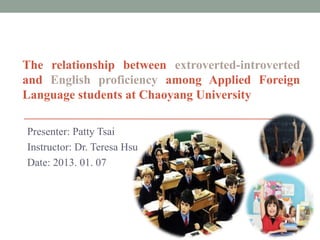
Final proposal
- 1. The relationship between extroverted-introverted and English proficiency among Applied Foreign Language students at Chaoyang University Presenter: Patty Tsai Instructor: Dr. Teresa Hsu Date: 2013. 01. 07
- 2. Table of contents Introduction Literature review Methodology 2
- 4. Background The classroom in Taiwan where English is learned as a foreign language (EFL), with the amount of approximately 45 students and only one teacher, it is not easy for teachers to notice the relationship between every student’s personality type and their English performance. 4
- 5. Purpose The purpose of this study attempts to probe into the relationship between extroversion- introversion and students’ English proficiency in Taiwan. 5
- 6. Research questions 1. Do English high intermediate level students with extroverted personality type perform better on their TOEIC tests than introverts? 1. Do the extroverts and introverts use the similar learning strategies when learning a second language? 6
- 7. Significance To provide an “empirical research” into the scarcity of information on Taiwanese English major students’ individual differences and their English proficiency. 7
- 9. What is personality? Personality is the type of person you are, which is shown by the way you behave, feel and think. (Sharma, 2008) Personality is defined as the sum total of our mental, emotional, social and physical characteristics that distinguishes us from others. They are what make us the unique person we are. (Yusoff, Rahim, & Esa, 2010) 9
- 10. Definitions of personality types Extraversion- This trait includes characteristics such as excitability, sociability, talkativeness, assertiveness and high amounts of emotional expressiveness. Agreeableness- This personality dimension includes attributes such as trust, altruism, kindness, affection, and other prosocial behaviors. Conscientiousness: Common features of this dimension include high levels of thoughtfulness, with good impulse control and goal-directed behaviors. Those high in conscientiousness tend to be organized and mindful of details. Neuroticism: Individuals high in this trait tend to experience emotional instability, anxiety, moodiness, irritability, and sadness. Openness: This trait features characteristics such as imagination and insight, and those high in this trait also tend to have a broad range of interests. (Fiske et al., 1949) 10
- 11. The notion of extroversion and introversion Extroverts are always regarded as “life of the party” person; in contrast, introverts are thought of as quite and reserved, with tendencies toward reclusiveness. Unfortunately, these stereotypes have influenced teacher’s perceptions of students, e.g., teachers always admire the talkative, outgoing students who participates freely in class discussions, rather than introverts who are sometimes thought of not being smart. (Brown, 1994) 11
- 12. Extroverted-introverted vs. English proficiency Many SLA theorists claimed that extroverts are the better language learners. (Shahila & Meenakshi, 2012) Introverts actually have higher English proficiency than the extroverted learners, which is not what she expected. (Busch, 1982) 12
- 13. Gap Even there were some SLA researchers focused on students’ English proficiency and extroversion-introversion factors, e.g., Busch’s study; still, there were very few research conducted in Asian, especially in Taiwan. 13
- 14. Hypothesis H1: Different personality types of learners especially extroversive learners can get higher scores on TOEIC test. H2: Different personality types of learners especially extroversive learners use better learning strategies than introverts. 14
- 15. METHODOLOGY 15
- 16. Methodology 16
- 17. MBTI questionnaire Version 1 Version 2 Version 3 93 items 66 items 28 items 17
- 18. Demographics 18
- 19. Procedure 19